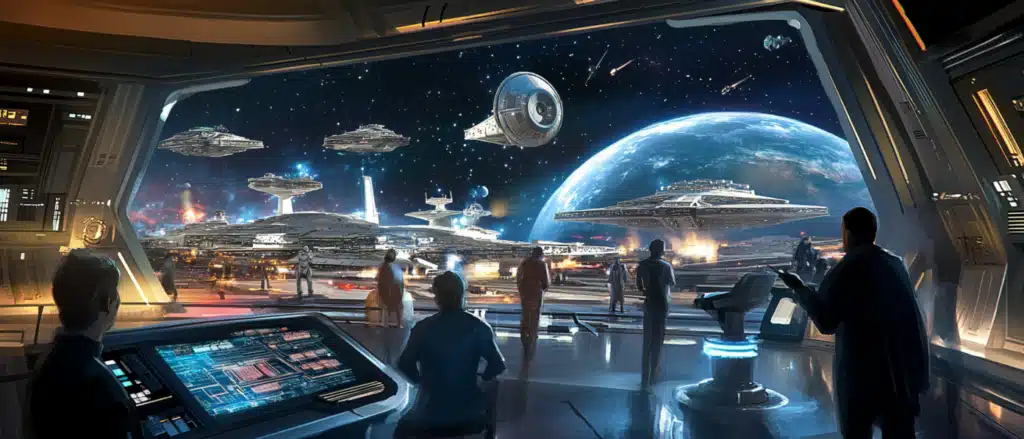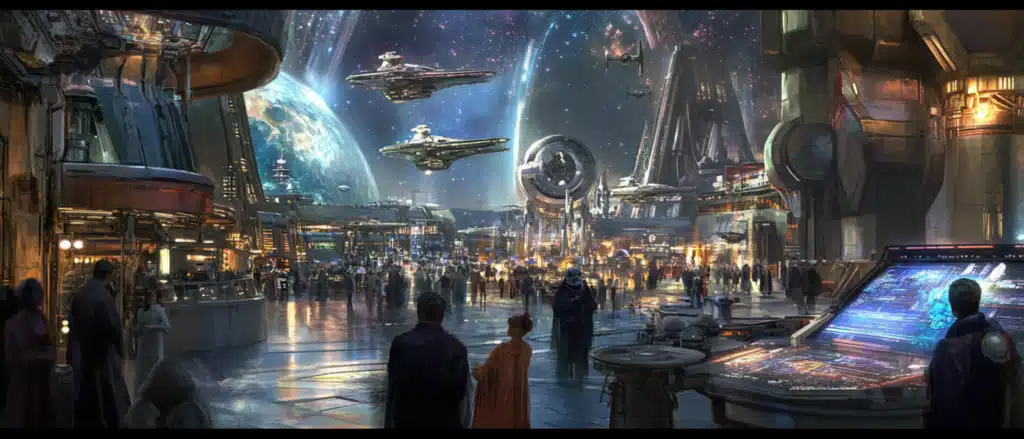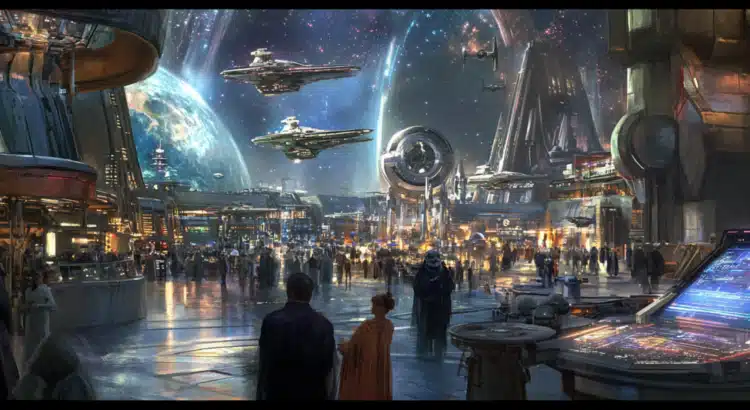In a galaxy far, far away, taxation of trade routes wasn’t just a matter of intergalactic bureaucracy—it was a powder keg that set off a chain reaction leading to the collapse of the Galactic Republic. For anyone wondering why Star Wars starts with a dispute over trade routes and taxation, this exploration of economic policy and politics sheds light on how such seemingly mundane matters could cause galactic unrest. From the manipulation of trade policies by the Galactic Senate to the rise of the Trade Federation, taxation in Star Wars is anything but simple.

Understanding the Role of Trade Routes in Galactic Economics
Trade routes in the Star Wars galaxy are vital arteries connecting planets, star systems, and entire sectors. Key trade routes like the Corellian Run, the Hydian Way, and the Perlemian Trade Route were instrumental in transporting goods, resources, and technology. The scale of this interstellar commerce was massive, with trillions of credits exchanging hands daily. However, as with any economy, taxation became a necessary mechanism to fund governance and maintain these routes.
The Galactic Republic’s policies on taxation were meant to regulate and protect these trade routes, but not everyone was pleased with how this system operated. Some systems viewed the taxation of their trade as excessive, especially when it primarily benefited Core Worlds like Coruscant. This imbalance fostered resentment among Outer Rim territories, where resources were often extracted without adequate reinvestment.
Key Trade Routes and Their Economic Significance
- The Corellian Run: A crucial route linking Core Worlds to the Outer Rim, facilitating the transport of luxury goods.
- The Hydian Way: One of the largest routes crossing the galaxy, connecting key planets such as Eriadu and Coruscant.
- The Perlemian Trade Route: A strategic route near the Mid Rim, vital for trade between the Republic and the border regions.
Controlling these trade routes gave significant economic and political leverage. Whoever taxed these routes essentially held power over interstellar commerce.

The Origins of the Trade Federation’s Power
The Trade Federation, often portrayed as a sinister conglomerate, initially had a legitimate economic purpose. Established to facilitate trade across vast distances, it represented the interests of various corporate entities. However, the Federation’s influence grew exponentially when it was granted significant autonomy to tax trade routes under the Galactic Republic’s laws.
In theory, this arrangement was supposed to stabilize trade and prevent piracy. In practice, it led to monopolistic behavior. The Trade Federation began imposing heavy tariffs on Outer Rim territories, enriching itself at the expense of less politically connected star systems. This created a growing divide between wealthy Core Worlds and resource-strapped Outer Rim planets.
As the Federation’s power grew, it established its own military capabilities, including the infamous droid army. Ostensibly for self-defense, this militarization became a crucial factor in the events leading to the Naboo blockade.

The Naboo Blockade: A Case Study in Tax Disputes
The taxation of trade routes reached a boiling point when the Trade Federation imposed a blockade on Naboo, a peaceful Mid Rim planet. The Federation’s justification? The Galactic Senate’s recent decision to tax their previously untaxed trade profits. Outraged by this perceived injustice, the Federation sought to make an example of Naboo, leveraging the planet’s strategic location to disrupt commerce.
What followed was a political debacle of galactic proportions. The Senate’s paralysis, exacerbated by corruption and conflicting interests, left Naboo without immediate support. This crisis would eventually draw the attention of Jedi Knights and set the stage for Darth Sidious’ machinations.
The Galactic Senate’s Role in Trade Policy
The Galactic Senate, though ostensibly a democratic institution, was notorious for inefficiency and corruption. Senators from wealthy Core Worlds often held disproportionate influence, while Outer Rim representatives struggled to make their voices heard. This imbalance shaped trade policies that favored powerful corporations like the Trade Federation, Commerce Guild, and Techno Union.
When disputes arose over taxation, debates in the Senate frequently stalled due to political gridlock. Lobbying efforts by corporate interests further complicated matters. The taxation crisis leading to the Naboo blockade highlighted the Senate’s inability to enforce equitable trade policies across the galaxy.
Economic Disparities Between Core and Outer Rim Worlds
One of the central tensions in Star Wars economics is the disparity between Core and Outer Rim systems. Core planets like Coruscant and Alderaan thrived as economic hubs, benefiting from advanced infrastructure and political clout. In contrast, Outer Rim planets such as Tatooine and Ryloth were often marginalized, facing exploitation without adequate resources for development.
This economic imbalance fueled resentment and, ultimately, rebellion. The seeds of the Separatist movement can be traced to these grievances, as disenfranchised systems sought autonomy from the Republic’s unfair trade practices.

The Separatist Movement and Economic Warfare
The Confederacy of Independent Systems (CIS), also known as the Separatists, capitalized on these tensions. Led by Count Dooku, the Separatists framed their cause as a fight against economic oppression. They argued that the Republic’s trade policies disproportionately favored the Core Worlds, leaving Outer Rim systems with no choice but to secede.
Economic warfare became a key strategy for the Separatists. By disrupting major trade routes, they sought to weaken the Republic’s economy. In response, the Republic intensified its military efforts, escalating the Clone Wars. Trade routes, once symbols of prosperity, became battlegrounds for control and survival.
The Impact of War on Trade
The Clone Wars devastated interstellar commerce. Blockades, piracy, and battles along key routes disrupted supply chains, causing widespread economic hardship. Planets dependent on trade for essential goods faced shortages, further exacerbating tensions. The Republic’s war effort also drained resources that could have been used to address underlying economic inequalities.
By the war’s end, the galaxy’s economy was in shambles. This instability provided an opportunity for Palpatine to consolidate power, transforming the Republic into the Galactic Empire under the guise of restoring order.

The Empire’s Approach to Trade and Taxation
Under Emperor Palpatine, the Galactic Empire adopted a more authoritarian approach to trade regulation. Major trade routes were placed under strict Imperial control, with heavy taxation and surveillance. While this brought temporary stability, it also entrenched economic disparities. Outer Rim territories continued to suffer under exploitative policies, fueling the rise of the Rebel Alliance.
The Empire’s emphasis on military-industrial expansion further skewed the economy. Resources were diverted toward the construction of weapons like the Death Star, leaving little room for economic recovery or development in marginalized regions. Trade became a tool of oppression rather than prosperity.

Lessons from Star Wars: Real-World Parallels
While Star Wars is a work of fiction, its depiction of trade disputes and taxation resonates with real-world history. Economic inequality, political corruption, and the consequences of monopolistic control are recurring themes in both the galaxy far, far away and our own world. Historical events such as the American Revolution, driven by protests against unfair taxation, mirror the struggles faced by Outer Rim systems.
Furthermore, the role of trade routes in shaping geopolitical power is evident throughout history. The Silk Road, maritime trade routes, and modern shipping lanes have all been sources of economic competition and conflict. Star Wars underscores the importance of fair trade policies and the dangers of unchecked corporate influence.

Conclusion: The High Cost of Trade Disputes
The taxation of trade routes in the Star Wars galaxies may seem like a minor plot point, but its implications are far-reaching. From the collapse of the Republic to the rise of the Empire, economic policies shaped the course of galactic history. Understanding these dynamics adds depth to the Star Wars narrative, offering insights into the complex interplay between politics, commerce, and conflict.
As we’ve seen, trade routes were more than just hyperspace highways; they were lifelines for entire civilizations. The struggle to control and tax these routes defined the power struggles of the galaxy, proving that even in a universe of lightsabers and starships, economics matters.
Stay connected with all our latest updates by following us on Google News! It only takes a click, and it would mean a lot to us. You’ll get the freshest news, exclusive content, and much more, right at your fingertips. Thanks for your support! 🙌










